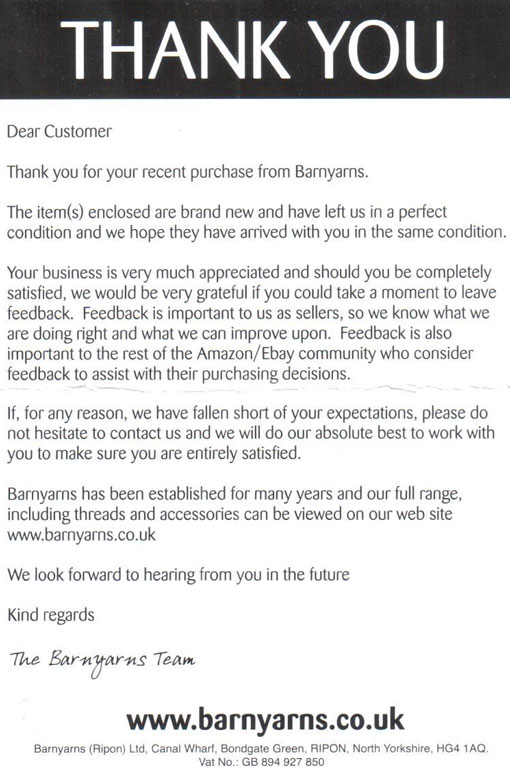3rd October 2018

Clear and professional customer service letters play an important role in shaping a customer’s experience with a company.
The way a business communicates in writing can influence how valued and supported a customer feels.
Whether responding to a complaint, providing an update on an order, or addressing an issue such as a billing error, a well-structured letter can turn a potentially negative experience into a positive one.
So are you looking to improve your customer service letters?
To help, we have put together advice on how to write a good customer service letter, covering key steps to ensure clarity, professionalism, and empathy, as well as giving examples to bring best practice to life.
Follow these seven steps to create a clear, professional, and effective customer service letter that addresses customer concerns while maintaining a positive relationship:
A clear subject line helps the customer understand the purpose of the letter immediately. It should be short and specific, including relevant details like an order number to make it easier for the customer to track the issue.
A straightforward subject line sets the right expectations and ensures it gets noticed.
Example
“Important Update Regarding Your Order Number 12345”
Date – The date is not typically included in the subject line but should be at the top of the letter. Use a standard date format, such as “31 July 2025,” to ensure clarity.
A polite and professional greeting creates a respectful tone and makes the letter feel more personal. If possible, address the customer by name, and avoid informal greetings like “Hey” or “Hi there,” as they may not be appropriate in a business setting.
Example
“Dear Mr. Smith,” or “Dear Ms. Smith”
Recognizing the issue shows the customer that their concern is being taken seriously. A simple acknowledgment reassures them that their frustration is understood.
This helps maintain a positive relationship, even if the news is not ideal. Keep the wording professional and avoid excessive apologies.
Example
“We understand how frustrating it can be to experience a delay with your order.”
Providing a clear explanation prevents confusion and reassures the customer that the issue is being handled. Use simple and direct language without unnecessary technical details.
Being transparent about the reason for the problem builds trust and helps the customer understand what has happened.
Example
“Due to unexpectedly high demand, we are currently experiencing delays in our shipping process.”
Let the customer know what is being done to resolve the issue. If offering a solution, be clear about the timeframe. If compensation is included, explain how the customer can use it. This helps manage expectations and ensures the customer feels valued.
Example
“We are working hard to speed up your order and it should arrive within the next three days. As a token of our appreciation for your patience, we are including a 20% discount on your next purchase.”
Clarifying what will happen next helps the customer know what to expect. If any action is required on their part, explain it clearly. If no action is needed, let them know so they feel reassured that the issue is being handled.
Example
“You will receive an updated tracking number via email shortly. No further action is required from your end.”
A polite and professional closing leaves a good impression and ensures the customer knows how to reach out if they have further questions. Provide clear contact details so they can easily get in touch if needed.
Example
“Thank you in advance for your patience. If you have any questions, please contact us at support@example.com or call us at 01234 567 890.
Yours Sincerely,
[Your Name] [Your Position] [Your Company]”
Here is an approach recommended by Fran Fish to help improve customer service letters:
Use simple, plain English. No jargon. Use headings and bullet points, so that the content is easy to follow and read.
Make sure there are no typos and all the provided information is “correct”. But the letter should also look and read the part – it should “look and sound like your brand.”
Answer all the questions that have been asked (and any that may come after). Get to the point quickly, as that’s the best way to reduce frustration and repeat contacts.
Using the right tone, that fits the reader (or customer) and the reason you’re contacting them. We expect the tone used in an apology letter to be different from the tone used in a special-offer email.
Fran also recommends that you “keep it personal and human and consider if a letter or email is really the right medium. Sometimes a quick, good-old-fashioned call works best.”
Remember, while in most cases it is good to stick to a customer’s channel preference, it is sometimes best to pick up the phone.
For example, if the customer has sent three or more letters over an issue, it might be best to pick up the phone to nip any rising customer frustration in the bud.
As an example of how to write customer service letters can be made actionable, we have provided two examples of customer service letters that were written by a car insurance company in response to the same customer query.
The first response is how the company originally thought of replying to the customer, following their old procedures. The second example is a rewrite of the first.
The letters are responses to a customer query which asked: “Am I covered if my kids’ laptops get stolen out of the car while I’m holiday?” The customer’s query letter was signed off with both their first and last name.
Dear Mr [SURNAME]Thank you for your enquiry.
We apologise for the delay in our response.
Personal Belongings cover is provided for the loss of or damage to (some) personal effects while in or on the insured car.
The insured must take reasonable care of the property and this does not extend to money, credit or debit cards. The cover is also not provided for soft-top/open cars. The amount payable will be shown on the Policy Schedule.
This covers you up to £300 per claim. I hope this answers your query.
Yours sincerely,
Hi [First name],Thanks for getting in touch about your kids’ iPads. Sorry it’s taken me a little longer to reply.
If the iPads were stolen from your car we’d cover up to £300 of their value.
Tip: It’s worth checking to see if your home insurance will cover a higher value.
Just so you know, if the worst does happen (and you want to make a claim), we’ll need you to have taken ‘reasonable care of the property’. That means:
I also need to tell you that we don’t cover theft from open and soft-top cars. You’ll find more information about what is and isn’t covered in our Policy Schedule online.
If you decide to take out insurance with us, the fastest and easiest way is to apply
online.
If there’s anything else I can help you with, please let me know.
Have a great holiday!
Fran Fish takes us through how the rewrite is an improvement in terms of the “clear, credible, answered and tone criteria”.
Mazaru and independent researchers ICM shared both car insurance letter examples with 2,000 consumers. The consumers were asked to share preferences and ‘next actions’, when comparing the two letters.
The results suggested that the car insurance company could benefit in each of the following ways by permanently switching to the style of the rewrite:
Below are three great examples of different types of customer service letters.
Here is a good response to a customer complaint about their credit profile.
Our response to your complaint
Dear [title last name/first name],
Thank you for getting in touch with us about your credit file. After looking into this for you, I’ve included my findings in this letter.
It might be easier to talk about this over the phone, so please give me a call if that would be helpful. I did try to call you a few times on [date] and [date] but couldn’t reach you.
Background
You’ve been in touch with us because you believe we have registered “default” or “repossession” on your credit file.
Checking your credit file
I’ve checked your payment history between [date] and [date] and found that each payment has been made on time. I could also see that you made your final payment of [£amount] on [date], which settled your account early.
I can confirm that we have recorded each payment, including your final settlement, as “paid on time” and have not registered a “default” or “repossession” against your credit file.
I hope that this answers your question and addresses your complaint. If you’d like to discuss this with me over the phone, please get in touch. You’ll find my number at the top of this letter.
Yours sincerely,
In this example, a customer service letter is used to warn residents of repair and maintenance work.
Dear resident,
We’re carrying out some work in your street.
We need to do some important repair and maintenance work outside [address].
This means parking will be restricted – we’ll put out cones to show you where you won’t be able to park.
When
[Time and date]
We’ll be finished by
[Time and date]
We’re sorry for the inconvenience – we’ll get the work done as quickly as we can. You can also find out more about why this happening and read regular updates on our website – just go to TheWaterCompany.com/streetworks
If you would like to contact us directly, call: 01234567890. You can also email: info@thewatercompany.com
Kind regards,
[Name]
Site Supervisor
While this may not be a perfect letter, there are many things to like about this customer service letter, created by Barnyarns.

But while it includes a number of nice “ingredients”, here are two ways in which it could have been improved:
For more on putting together a good thank-you letter, read our article: How to Write a Thank-You Letter to a Customer
Thanks to Mazaru for sharing some of the example letters that we’ve used in this article.
To find more of our advice on writing for customer service, read our articles:
Reviewed by: Jonty Pearce